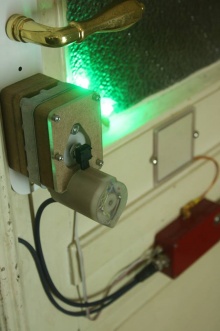WoW: Unterschied zwischen den Versionen
Bilex (Diskussion | Beiträge) Keine Bearbeitungszusammenfassung |
Bilex (Diskussion | Beiträge) KKeine Bearbeitungszusammenfassung |
||
| Zeile 38: | Zeile 38: | ||
=== | ===Joystick-Imitation=== | ||
To make the motors radio controlled you need to get data into the system. In general there a couple of ways to do so. The easiest way is to manipulate the joystick mechanically. (Look at this amazing solution on Youtube | To make the motors radio controlled you need to get data into the system. In general there a couple of ways to do so. The easiest way is to manipulate the joystick mechanically. (Look at this amazing solution on Youtube | ||
https://www.youtube.com/watch?v=88oaO4ipiYk | https://www.youtube.com/watch?v=88oaO4ipiYk | ||
). Another approach is to get deeper into the CAN-Bus communication between the power module and the joystick to send appropriate data with an external uC. A less complex but still satisfying solution is to fake the joystick. A quick look at the joystick itself shows that it consist of two potentiometers working as a voltage divider. To generate these two variable voltages from zero to five volt a Teensy-Board is programmed in Arduino. Two PWM channels are turned into analog signals with a low pass filter. The filter uses only a resistor and capacitor, for a very simple and low cost way to obtain an analog signal. As safety is an issue when moving +200kg the Teensy-Board is programmed to bring the virtual joystick to a neutral position if there is no data longer than 100ms. | ). Another approach is to get deeper into the CAN-Bus communication between the power module and the joystick to send appropriate data with an external uC. A less complex but still satisfying solution is to fake the joystick. A quick look at the joystick itself shows that it consist of two potentiometers working as a voltage divider. To generate these two variable voltages from zero to five volt a Teensy-Board is programmed in Arduino. Two PWM channels are turned into analog signals with a low pass filter. The filter uses only a resistor and capacitor, for a very simple and low cost way to obtain an analog signal. As safety is an issue when moving +200kg the Teensy-Board is programmed to bring the virtual joystick to a neutral position if there is no data longer than 100ms. | ||
== Download CAD Data == | == Download CAD Data == | ||
Version vom 21. August 2014, 12:11 Uhr
| WoW Release status: stable [box doku] | |
|---|---|

| |
| Description | Whitcube on Wheels |
| Author(s) | A.B. (Bilex) |
| Platform | Representation |
Information
Whitecube on Wheels is a remote-controlled, battery-driven onstage stage. If you want to be mobile with people performing onstage on a stage, WoW fits to your needs. WoW is able to carry up to four people and can be controlled accurately from 0-6km/h by using a WiFi connection. Besides going forwards and backwards it is able to perform rotations around its own axis. Wow is dismountable to make transportation less challenging.
Mechanics
In principle WoW works like a wheelchair with increased wheelbase. Both motors and wheels are taken from a wheelchair. The construction itself is a mixture of wood and welded steel assemblies. YNNOK was designed with Autodesk Inventor .
Electronics
A wheelchair comes with everything you need to maneuver high loads if you rely on battery operation. WoW is equipped with two 150W DC drive units. Compared to DIY solutions, the drive system that comes with the wheelchair is a hassle-free out of the box solution. It provides a joystick, battery monitoring, several speed levels, acceleration management (ramping), automatic motor break release and offers a steering management by speeding the wheels with variable speed. Two 25Ah Pb batteries are used to provide a couple of hours driving fun.
Joystick-Imitation
To make the motors radio controlled you need to get data into the system. In general there a couple of ways to do so. The easiest way is to manipulate the joystick mechanically. (Look at this amazing solution on Youtube https://www.youtube.com/watch?v=88oaO4ipiYk ). Another approach is to get deeper into the CAN-Bus communication between the power module and the joystick to send appropriate data with an external uC. A less complex but still satisfying solution is to fake the joystick. A quick look at the joystick itself shows that it consist of two potentiometers working as a voltage divider. To generate these two variable voltages from zero to five volt a Teensy-Board is programmed in Arduino. Two PWM channels are turned into analog signals with a low pass filter. The filter uses only a resistor and capacitor, for a very simple and low cost way to obtain an analog signal. As safety is an issue when moving +200kg the Teensy-Board is programmed to bring the virtual joystick to a neutral position if there is no data longer than 100ms.
Download CAD Data
Here you can download the mechanical part of the game in *STEP and *IGES data.



